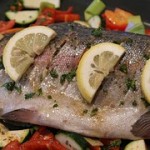Our awareness of eating more fish heightens this time of year as we enter the Lenten season. Grocery stores promote more fish and seafood, restaurants offer seafood meal specials and community and church organizations host their annual Lenten fish fries. Truly, fish is a great food any time of year. The 2010 Dietary Guidelines recommend increasing the consumption of seafood. The recommendation is to eat fish twice a week for a total of about 8 ounces. To give you an idea of a portion, a salmon steak would be 4 to 6 ounces, a small trout would be about 3 ounces and a can of tuna, drained, would be about 3 to 4 ounces.
Seafood is considered a nutrient dense food which means that it has a lot of nutrients packed into a small package. Fish has a significant amount of high quality protein and is low in total fat, sodium, and calories as compared to other foods such as meat. Many types of fish have healthy omega-3 fatty acids. These fatty acids are a benefit to people who have cardiovascular disease or who are at high risk for the disease. The American Heart Association (www.heart.org) supports the recommendation that consumers should eat salmon, herring, lake trout, mackerel, albacore tuna or sardines which are rich in omega-3 fatty acids.
Some fish that are higher in omega-3s and also lower in mercury include salmon, trout, Atlantic and Pacific mackerel, sardines, herring and oysters. Some seafood such as mussels, clams and calamari also supply omega-3s.
All fish and seafood should be cooked and handled safely. FDA’s “FoodFacts” (http://www.fda.gov/Food/ResourcesForYou/Consumers/ucm077331.htm) offers facts on buying, storing, preparing and serving fish and seafood safely. Fish needs to be cooked to 145 ̊F and will be opaque and will easily separate with a fork.
Tips for cooking fish:
- Fish can be baked, grilled, broiled, or roasted without adding extra fat and calories.
- Be aware of fried fish, breaded fish, and the added creamy sauces because they add fat and calories.
- Low-sodium seasonings, herbs, spices, and even lemon juice can add flavor without adding calories. There are lots of recipes available for fish and seafood, so be creative beyond the basic fish stick.
- Canned salmon, tuna, and sardines can be kept on hand for quick, easy to make meals. Read the label, tuna canned in water is a healthier choice. ChooseMyPlate.gov has a great tip sheet on getting more seafood into your diet.
Fresh, frozen or canned? There are lots of options. Many grocery stores offer a variety of fresh fish and seafood as well as frozen and canned products. If buying fresh fish, only buy fish that is refrigerated or that is displayed on a thick bed of fresh ice in a case or with some type of cover. For frozen fish, don’t buy if the package has signs of ice crystals. This means the fish has been thawed and refrozen or has been stored for a long time.
Fish and seafood doesn’t have to be expensive. Many grocery stores run weekly seafood specials. I like to buy fresh fish at my local grocery store because I can get the exact amount I want, save money, and have little or no waste. If I only want one half pound of tilapia or a dozen small salad shrimp or even a one pound salmon filet, I can get it. From the frozen seafood isle, I can find a package of frozen perch that has been individually frozen, so I can use just the amount I want.


